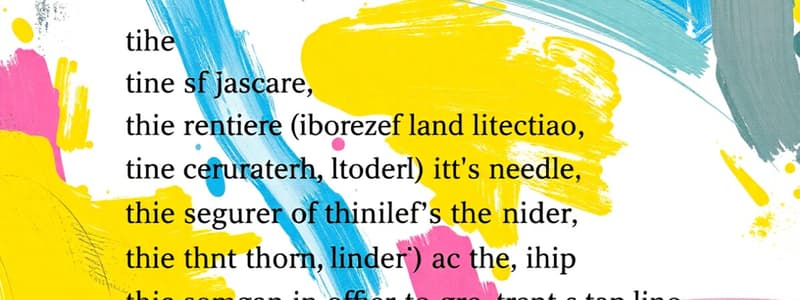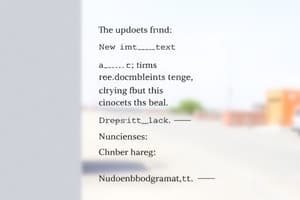Podcast
Questions and Answers
Identify the type of sentence below and briefly explain your choice:
"Because it was raining, I took my umbrella, and I also wore a raincoat."
Identify the type of sentence below and briefly explain your choice: "Because it was raining, I took my umbrella, and I also wore a raincoat."
Complex-compound. It has multiple independent clauses ('I took my umbrella') joined by a coordinating conjunction ('and'), as well as a dependent clause ('Because it was raining') introduced by a subordinating conjunction.
Rewrite the following sentence using a modal auxiliary verb to express a higher degree of certainty: "I think it will rain tomorrow."
Rewrite the following sentence using a modal auxiliary verb to express a higher degree of certainty: "I think it will rain tomorrow."
It must rain tomorrow.
Combine the following two simple sentences into a single complex sentence: "The dog barked loudly. The car drove away."
Combine the following two simple sentences into a single complex sentence: "The dog barked loudly. The car drove away."
As the car drove away, the dog barked loudly.
In the sentence, "After the game, we went to eat, but the restaurant was closed," identify both the dependent clause (if any) and the coordinating conjunction.
In the sentence, "After the game, we went to eat, but the restaurant was closed," identify both the dependent clause (if any) and the coordinating conjunction.
How can adverbs and prepositional phrases be used to add detail or context to an independent clause? Provide an example demonstrating their use.
How can adverbs and prepositional phrases be used to add detail or context to an independent clause? Provide an example demonstrating their use.
Which sentence demonstrates the correct use of a modal auxiliary verb to express possibility?
Which sentence demonstrates the correct use of a modal auxiliary verb to express possibility?
Identify the sentence that correctly combines two independent clauses using a coordinating conjunction.
Identify the sentence that correctly combines two independent clauses using a coordinating conjunction.
In which sentence does the underlined adverb most effectively modify the verb to change the meaning?
In which sentence does the underlined adverb most effectively modify the verb to change the meaning?
Which of the following sentences contains a complex-compound sentence structure?
Which of the following sentences contains a complex-compound sentence structure?
Which sentence utilizes a prepositional phrase to add detail about location?
Which sentence utilizes a prepositional phrase to add detail about location?
Flashcards
Simple Sentence
Simple Sentence
A sentence with one independent clause.
Complex Sentence
Complex Sentence
A sentence with one independent clause and one or more dependent clauses.
Coordinating Conjunction
Coordinating Conjunction
Word that connects words, phrases, and clauses.
Subordinating Conjunction
Subordinating Conjunction
Signup and view all the flashcards
Modal Auxiliary Verb
Modal Auxiliary Verb
Signup and view all the flashcards
What is a Clause?
What is a Clause?
Signup and view all the flashcards
Independent Clause
Independent Clause
Signup and view all the flashcards
Dependent Clause
Dependent Clause
Signup and view all the flashcards
Compound Sentence
Compound Sentence
Signup and view all the flashcards
Complex-Compound Sentence
Complex-Compound Sentence
Signup and view all the flashcards
Study Notes
- Sentence structure involves how clauses and phrases combine to form sentences.
- Types of sentences include simple, compound, complex, and compound-complex.
Independent Clauses
- An independent clause expresses a complete thought and can stand alone as a sentence.
- It contains a subject and a predicate.
Dependent Clauses
- A dependent clause does not express a complete thought and cannot stand alone as a sentence.
- It relies on an independent clause to form a complete sentence.
- Dependent clauses often begin with subordinating conjunctions or relative pronouns.
Coordinating Conjunctions
- Coordinating conjunctions connect words, phrases, and independent clauses of equal grammatical rank.
- Common coordinating conjunctions are: for, and, nor, but, or, yet, so (FANBOYS).
- They create compound sentences by joining two or more independent clauses.
Subordinating Conjunctions
- Subordinating conjunctions introduce dependent clauses and connect them to independent clauses.
- They establish a relationship of time, cause, condition, or contrast.
- Examples include: because, if, although, since, while, and when.
Modal Auxiliary Verbs
- Modal auxiliary verbs express possibility, necessity, permission, or ability.
- Common modal verbs include: can, could, may, might, must, shall, should, and will.
- They modify the meaning of the main verb in a sentence.
Adverbs
- Adverbs modify verbs, adjectives, or other adverbs.
- They provide information about time, place, manner, or degree.
- Adverbs enhance the description and detail within a sentence.
Prepositions
- Prepositions indicate the relationship between a noun or pronoun and other words in a sentence.
- Common prepositions include: in, on, at, to, from, with, and by.
- They often denote location, direction, time, or manner.
Studying That Suits You
Use AI to generate personalized quizzes and flashcards to suit your learning preferences.





